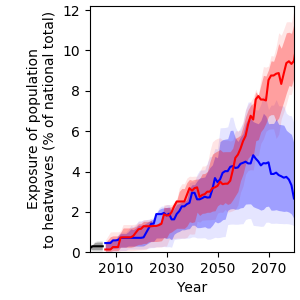Uganda: Human health
Climate change threatens the health and sanitation sector through more frequent incidences of heatwaves, floods, droughts and storms. Among the key health challenges in Uganda are morbidity and mortality through HIV / AIDS, vector-borne diseases such as malaria, respiratory diseases, tuberculosis and waterborne diseases related to extreme weather events (e.g. flooding), such as diarrhoea and mortality, which can increase the risk of malnutrition, hunger and death by famine [30]. Scientific investigations among smallholder farmers in Uganda found a strong link between drought, food security and stunting [31]. Stunting rates differ among regions: In Tooro in western Uganda, 41 % of children under the age of five are stunted, while in Teso in eastern Uganda, the stunting rate is at 14 % [32]. Furthermore, climate change is likely to lengthen transmission periods and alter the geographic range of vector-borne diseases, for instance, due to changes in precipitation and rising temperatures. Increases in precipitation in addition to more frequent and extreme flooding could increase the risk of malaria [33]. Temperature increases could allow for transmission in areas which were previously free of malaria, such as the highlands [34]. However, when exceeding 33 °C, transmission may also decrease [35]. In Uganda, malaria is the most frequently reported disease at both public and private health facilities with 12.4 million cases and 13 203 deaths in 2018, according to WHO estimates [36].
Exposure to heatwaves
Rising temperatures will result in more frequent heatwaves in Uganda, leading to increased heat-related mortality. Under RCP6.0, the population affected by at least one heatwave per year is projected to increase from 0.2 % in 2000 to 9.5 % in 2080 (Figure 17).

Heat-related mortality
Furthermore, under RCP6.0, heat-related mortality will likely increase from approximately 2 to about 8 deaths per 100 000 people per year, which translates to an increase by a factor of four towards the end of the century compared to year 2000 levels, provided that no adaptation to hotter conditions will take place. Under RCP2.6, heat-related mortality is projected to increase to about 5 deaths per 100 000 people per year in 2080 (Figure 18).

References
[30] Centers for Disease Control and Prevention (CDC), “CDC in Uganda,” Atlanta, Georgia, 2019.
[31] S. Ly, P. O. Okello, R. Mpiira, and Z. Ali, “Climate Event Consequences on Food Insecurity and Child Stunting Among Smallholder Farmers in Uganda: A Cross-Sectional Study,” Lancet Glob. Heal., 2018.
[32] USAID, “Uganda: Nutrition Profile,” Washington, D.C., 2018.
[33] R. Boyce, R. Reyes, M. Matte, M. Ntaro, E. Mulogo, J. P. Metlay, L. Band, and M. J. Siedner, “Severe Flooding and Malaria Transmission in the Western Ugandan Highlands: Implications for Disease Control in an Era of Global Climate Change,” J. Infect. Dis., vol. 214, pp. 1403–1410, 2016.
[34] D. Alonso, M. J. Bouma, and M. Pascual, “Epidemic Malaria and Warmer Temperatures in Recent Decades in an East African Highland,” Proc. R. Soc. B, vol. 278, pp. 1661–1669, 2011.
[35] P. E. Parham and E. Michael, “Modeling the Effects of Weather and Climate Change on Malaria Transmission,” Environ. Health Perspect., vol. 118, pp. 620–626, 2010.
[36] WHO, “World Malaria Report 2019,” Rome, Italy, 2019.


